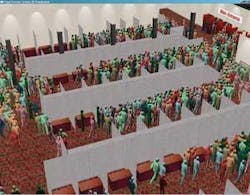By Courtney E. Howard
WASHINGTON - The Pentagon and the Defense Advanced Research Projects Agency (DARPA) contracted Regal Decision Systems of Linthicum, Md., to develop a prototype system for the Pentagon to detect chemical and biological agents, as well as identify evacuation routes for its 20,000-plus occupants to minimize exposure to the detected hazards and get people out of the building quickly and safely.
The Pentagon is the largest office building in the world, with an average of 20,000 occupants per day and as many as 35,000 occupants on the busiest days. Arguably the most visible target in the world, the Pentagon is especially vulnerable to attack. As a result, Pentagon employees sought an intelligent system able to gather, analyze, and present critical data-including threat description and movement, building density, and evacuation priorities-and help occupants exit the building safely and efficiently.
Regal responded with its Evacuation Guidance System (EGS) software that analyzes threat data and building occupancy information and then provides, via a directional lighting system, guided routing and exit paths for building occupants.
The EGS takes advantage of simulation modeling to direct evacuees away from threats and toward the safest exits as quickly as possible. It also responds to changes in contaminant path and chokepoints in real time. A microsimulation provides evacuation emulation and evaluation, and an optimizer determines the optimal exit routes for minimized contamination exposure and reduced overall evacuation time.
The optimizer employs an integer linear program formulation with a “branch and bound” search algorithm. The micro-simulation uses a grid-based occupant flow technique, developed by Regal, that represents human behavior in a guided evacuation situation and simulates pedestrian and crowd movement. The microsimulation and optimizer work in tandem to evaluate three contamination thresholds to determine the best routing, which it then communicates to a systems integrator who provides the color and direction for each lighting segment installed in the building.
One comparative analysis indicates a decrease in occupant contamination exposure of 90 percent, Regal executives say. When routing is determined by the optimizer without contamination, the evacuation time is 40 percent faster than existing routes.
Regal collaborated with other technology companies to ensure the solution’s seamless integration with existing Pentagon building systems, such as HVAC and electrical. In fact, 27 contractors were involved in the project, including National Institute of Standards and Technology (NIST) of Gaithersburg, Md.; ENSCO Inc. of Falls Church, Va.; Lawrence Livermore National Laboratory in Livermore, Calif.; Northrop Grumman of Los Angeles; and Johnson Controls Inc. in Milwaukee, Wis.
The EGS prototype was tested in October 2005 as a proof-of-concept in one of the five wedges of the Pentagon. It marks the first time the dynamic evacuation system has been employed in a federal building. The implementation of the EGS prototype at the Pentagon demonstrates the system’s ability to be replicated across many other large buildings to enhance U.S. homeland security. Regal representatives expect this evacuation system to be implemented throughout the Pentagon and in other federal buildings.

